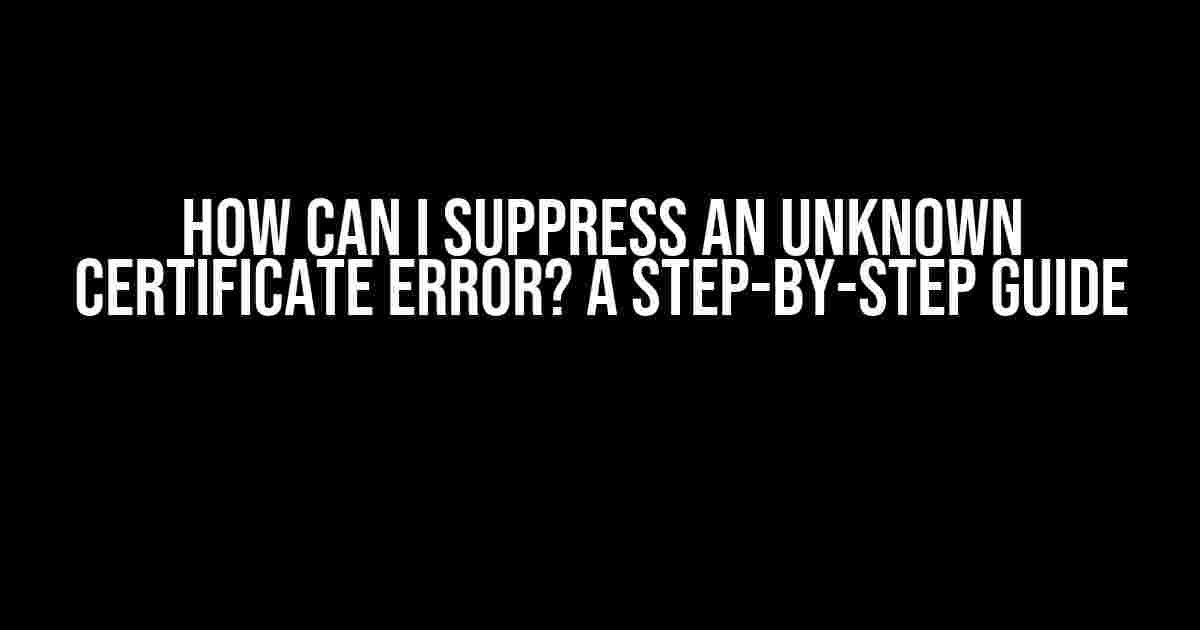Are you tired of encountering those pesky unknown certificate errors that disrupt your online experience? Don’t worry, you’re not alone! In this comprehensive guide, we’ll walk you through the process of suppressing unknown certificate errors, ensuring you can browse the internet with confidence and peace of mind.
- Understanding Unknown Certificate Errors
- Suppressing Unknown Certificate Errors
- Method 1: Ignoring Certificate Errors in Google Chrome
- Method 2: Disabling Certificate Verification in Firefox
- Method 3: Using the `–ignore-certificate-errors` Flag in Chrome and Edge
- Method 4: Adding the Certificate to the Trusted Store (Windows)
- Method 5: Using OpenSSL to Generate a Trusted Certificate
- Conclusion
- FAQs
Understanding Unknown Certificate Errors
Before we dive into the solution, it’s essential to understand what’s happening behind the scenes. When you visit a website, your browser checks the site’s SSL/TLS certificate to ensure it’s valid and trustworthy. If the certificate is unknown, expired, or self-signed, your browser will display an error message, warning you about the potential risks.
Reasons for Unknown Certificate Errors
- Self-signed certificates**: Some websites use self-signed certificates, which aren’t trusted by default by most browsers.
- Expired or invalid certificates**: Certificates can expire or become invalid, causing browsers to flag them as unknown.
- Misconfigured certificates**: Poorly configured certificates can lead to errors and warnings.
- Browser-specific issues**: Sometimes, browser-specific configurations or settings can trigger unknown certificate errors.
Suppressing Unknown Certificate Errors
Now that we’ve covered the basics, let’s explore the methods to suppress unknown certificate errors. Please note that these methods are primarily for development, testing, or troubleshooting purposes only. We don’t recommend bypassing certificate errors for sensitive or critical applications.
Method 1: Ignoring Certificate Errors in Google Chrome
Chrome provides an easy way to ignore certificate errors for a specific website or domain:
chrome://flags/#allow-insecure-localhost
Enable the “Allow invalid certificates for resources loaded from localhost” flag and restart Chrome. This will allow you to access local development environments or testing servers with self-signed certificates.
Method 2: Disabling Certificate Verification in Firefox
Firefox allows you to disable certificate verification for specific domains or websites:
about:config
Search for “security.enterprise_roots.enabled” and set it to “true”. Then, add the domain or website you want to trust to the “security.exception.uri” list. For example:
security.exception.uri=https://example.com
Restart Firefox to apply the changes.
Method 3: Using the `–ignore-certificate-errors` Flag in Chrome and Edge
You can launch Chrome or Edge with the `–ignore-certificate-errors` flag to bypass certificate errors:
chrome --ignore-certificate-errors
or
msedge --ignore-certificate-errors
This method is useful for quick testing or development purposes, but be cautious when using it, as it compromises your browser’s security.
Method 4: Adding the Certificate to the Trusted Store (Windows)
On Windows, you can add the unknown certificate to the Trusted Store:
- Export the certificate from the website (usually available in the browser’s developer tools or by clicking the padlock icon).
- Open the Microsoft Management Console (MMC) and add the Certificates snap-in.
- Import the exported certificate into the “Trusted Root Certification Authorities” store.
Restart your browser or system to apply the changes.
Method 5: Using OpenSSL to Generate a Trusted Certificate
For more advanced users, OpenSSL can be used to generate a trusted certificate:
openssl req -x509 -newkey rsa:2048 -nodes -keyout example.com.key -out example.com.crt -days 365 -subj "/C=US/ST=State/L=Locality/O=Organization/CN=example.com"
This command generates a self-signed certificate for “example.com” with a private key. You can then add this certificate to your Trusted Store or use it in your application.
Conclusion
Suppressing unknown certificate errors can be useful in specific scenarios, but it’s essential to remember that certificates play a critical role in ensuring online security. When working with sensitive data or applications, always prioritize security and use trusted, validated certificates.
By following the methods outlined in this guide, you’ll be able to bypass certificate errors and access websites or applications that would otherwise be blocked. However, please exercise caution and only use these methods when necessary, as they can compromise your browser’s security.
| Method | Browsers | Description |
|---|---|---|
| Ignoring Certificate Errors in Chrome | Chrome | Enable a flag to ignore certificate errors for localhost |
| Disabling Certificate Verification in Firefox | Firefox | Disable certificate verification for specific domains or websites |
| Using the `–ignore-certificate-errors` Flag | Chrome, Edge | Launch the browser with a flag to bypass certificate errors |
| Adding the Certificate to the Trusted Store (Windows) | All | Add the unknown certificate to the Trusted Store on Windows |
| Using OpenSSL to Generate a Trusted Certificate | All | Generate a trusted certificate using OpenSSL |
Remember to always prioritize security and use trusted certificates whenever possible. If you’re unsure about how to handle unknown certificate errors, consider consulting with a security expert or IT professional.
FAQs
Q: Are unknown certificate errors a sign of a phishing or malware attack?
A: Not necessarily. Unknown certificate errors can occur due to various reasons, including self-signed or expired certificates. However, it’s essential to exercise caution and verify the website’s authenticity before proceeding.
Q: Can I suppress unknown certificate errors permanently?
A: We don’t recommend suppressing unknown certificate errors permanently, as it can compromise your browser’s security. Instead, use the methods outlined in this guide for specific scenarios or testing purposes only.
Q: Will suppressing unknown certificate errors affect my browser’s performance?
A: Suppressing unknown certificate errors should not affect your browser’s performance. However, if you’re using a method that involves adding certificates to the Trusted Store or using a flag, you might notice a slight performance impact.
By following this comprehensive guide, you’ll be well-equipped to handle unknown certificate errors and enjoy a seamless online experience. Remember to always prioritize security and use trusted certificates whenever possible.
Frequently Asked Question
Are you tired of dealing with unknown certificate errors? Worry no more! We’ve got you covered with our expert answers to your most pressing questions.
What causes unknown certificate errors, and how can I identify them?
Unknown certificate errors occur when your browser or application can’t verify the identity of a website or server. This can happen due to expired, self-signed, or misconfigured certificates. To identify these errors, look for warnings or alerts from your browser, such as “This connection is not private” or “The identity of this website cannot be verified.” You can also check the certificate details by clicking on the padlock icon in the address bar.
Can I simply ignore the unknown certificate error and proceed?
We strongly advise against ignoring unknown certificate errors. Proceeding with an unverified connection can put your sensitive data at risk of being intercepted or stolen by malicious actors. It’s essential to verify the identity of the website or server before entering any sensitive information.
How can I suppress unknown certificate errors in my web browser?
You can suppress unknown certificate errors in your web browser by adding the website or server to your trusted sites list or by installing the certificate in your browser’s certificate store. However, be cautious when doing so, as this can potentially compromise your security.
What are some best practices for handling unknown certificate errors in my application?
When handling unknown certificate errors in your application, always prioritize security over convenience. Implement certificate pinning, use trusted Certificate Authorities, and ensure your application is configured to verify certificates correctly. Additionally, provide clear error messages and guidance to your users to help them make informed decisions.
Are there any tools or software that can help me manage and suppress unknown certificate errors?
Yes, there are various tools and software available that can help you manage and suppress unknown certificate errors. These include certificate management software, SSL/TLS inspection tools, and proxy servers. Some popular options include OpenSSL, Burp Suite, and Fiddler. Research and choose the tool that best fits your specific needs and requirements.


